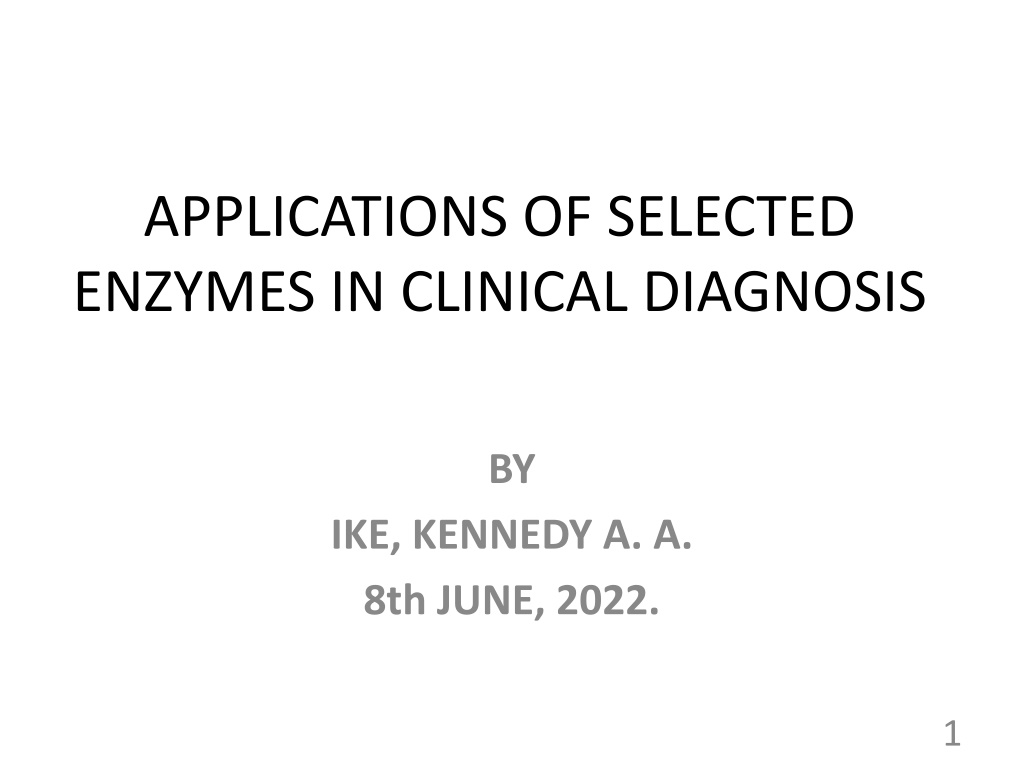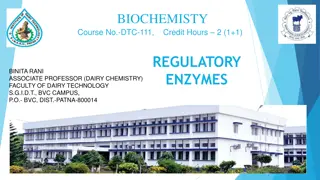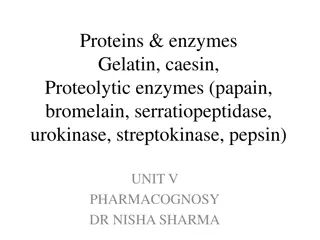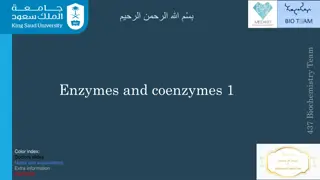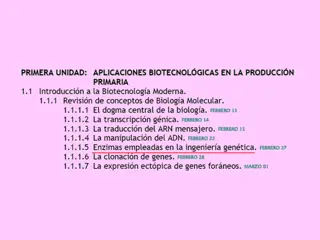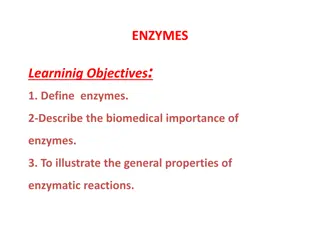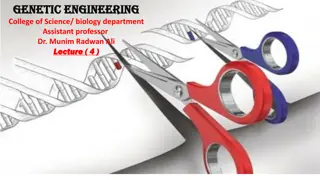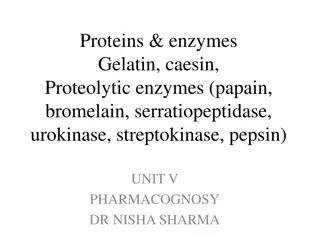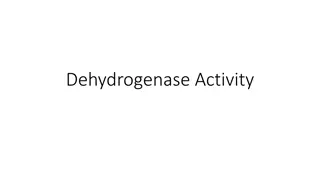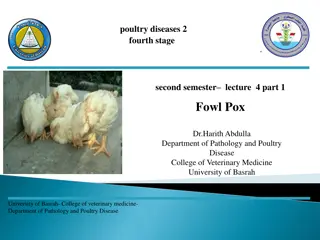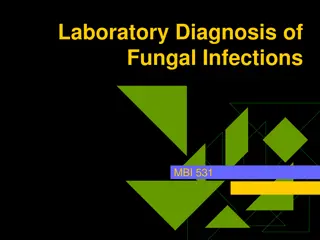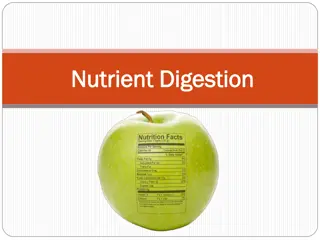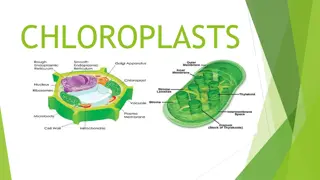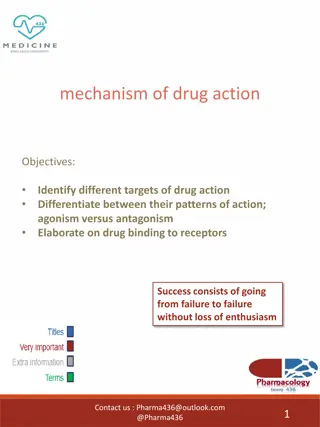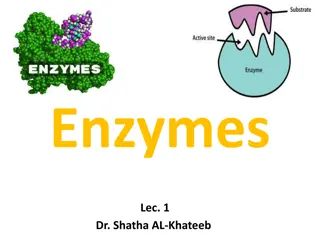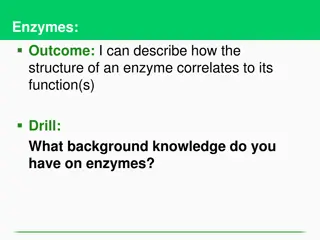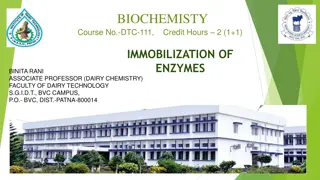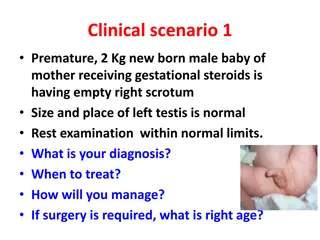Applications of Enzymes in Clinical Diagnosis: A Comprehensive Overview
Enzymes play a crucial role in cellular metabolism and are essential for various biochemical reactions in living organisms. This detailed study explores the sources, classification, properties, and factors affecting enzymes, emphasizing their applications in diagnostic and analytical processes. By highlighting the significance of enzymes in clinical diagnosis, this research sheds light on their catalytic efficiency and impact on health assessment.
Download Presentation

Please find below an Image/Link to download the presentation.
The content on the website is provided AS IS for your information and personal use only. It may not be sold, licensed, or shared on other websites without obtaining consent from the author. Download presentation by click this link. If you encounter any issues during the download, it is possible that the publisher has removed the file from their server.
E N D
Presentation Transcript
APPLICATIONS OF SELECTED ENZYMES IN CLINICAL DIAGNOSIS BY IKE, KENNEDY A. A. 8th JUNE, 2022. 1
OUTLINE: Introduction Sources of Enzymes Classification Properties Factors Affecting Enzymes Applications: Diagnostic Analytical Reagents Conclusion References 2
OBJECTIVE To highlight the applications of selected enzymes in diagnosis 3
INTRODUCTION The cell is the structural and functional unit of life the basic building block of living systems. Cells have the capability to effectively utilize enzymes, which have outstanding catalytic efficiency. Enzymes are crucial for cellular metabolism. Every chemical reaction that takes place in plants, micro-organisms and animals proceeds at a quantifiable rate as a direct result of enzymatic reaction. 4
INTRODUCTION CONTD The word Enzyme was first used by a German Physiologist Wilhelm Kirhne in 1878, when he was describing the ability of yeast to produce alcohol from sugars. Enzyme was derived from Greek words en (meaning within ) and zume (meaning yeast ). It was believed that all enzymes were proteins, but in 1980s it was found that ribonucleic acid (RNA) molecules are also able to exert catalytic effects. These RNAs (ribozymes) play an important role5
WHAT ARE ENZYMES? Enzymes are biological catalysts (biocatalysts) that speed up biochemical reactions in living organisms and affect every function of the body from digestion to breathing. Functionally, enzymes facilitate cellular reactions that may not otherwise occur, by lowering the threshold of energy required for those reactions to take place. 6
SOURCES OF ENZYMES Animal sources: Lipase from pancreas. Trypsin from ox bile. Urokinase from human urine. Chymotrypsin from ox bile and pancreas. Pepsin from hog pancreas. Lysozyme from hen egg. 7
SOURCES OF ENZYMES CONTD Plant Sources: Papain from pawpaw Amylase from barley Bromelain from pineapple Nattokinase from Natto 8
SOURCES OF ENZYMES CONTD Microbial Sources: Streptokinase from beta haemolytic Streptococci. Glutaminase from E. Coli Amylase from Bacillus Lipase from Aspergillus 9
CLASSIFICATION OF ENZYMES According to the International Union of Biochemists (IUB), enzymes are divided into six (6) functional classes based on the type of reaction they catalyze. They include: Oxidoreductases Transferases Hydrolases Lyases Isomerases Ligases 10
PROPERTIES OF ENZYMES Speed up chemical reactions. Highly specific in their action. Required in minute amounts. Affected by temperature. Affected by PH Some catalyse reversible reactions. Some require co-enzymes. 11
FACTORS AFFECTING ENZYME ACTIVITIES Concentration of enzyme. Concentration of substrate. Effect of temperature. Effect of PH. Effect of product concentration. Effect of activators. 12
BASIC DIAGNOSTIC APPLICATIONS Enzymes of the liver, kidney, skeletal muscles, heart, etc leak into blood during related disorders. The measurement of the serum levels of these enzymes has shown to be of diagnostic significance. This is because the presence of these enzymes in the serum indicates that tissue or cellular damage has occurred resulting in the release of intracellular components into the blood. 13
BASIC DIAGNOSTIC APPLICATIONS CONT D Commonly assayed enzymes but not limited to these: Aspartate aminotransferase (AST) Alanine aminotransferase (ALT) Acid phosphatase (ACP) Prostate Specific Antigen (PSA) Alkaline Phosphatase (ALP) 14
BASIC DIAGNOSTIC APPLICATIONS CONTD 5'-Nucleotidase (5' NT) Gamma-Glutamyltransferase (GGT) Creatine Kinase (CK) Lactate Dehydrogenase (LDH) 15
AST/ALT AST catalyses the transamination of L-aspartate and 2-oxoglutarate to oxaloacetate and glutamate. ALT catalyses the transamination of L-alanine and 2- oxoglutarate to pyruvate and glutamate. They are found in the liver, kidney, skeletal muscle, heart, erythrocytes. Under normal circumstances, the AST fraction is usually higher than the ALT fraction, i.e. the ratio of AST to ALT is usually greater than one (>1). 16
ACP It catalyses the conversion of phosphomonoesters to alcohol and phosphoric acid under an acidic condition (PH 5). The ACP found in serum is a combination of isoenzymes derived from the prostate gland, spleen, platelets, erythrocytes, liver and bone. The most diagnostically useful ACP is the prostate isoenzyme usually called prostatic ACP. The enzyme is produced in the prostate and secreted in the semen. 17
ACP Contd Semen is a very rich source of ACP and therefore very important in forensic examination of rape cases. ACP appears in high activity in serum in prostatic cancer. Although ACP is widely used as a marker for prostate cancer, less than 50% of patients with prostate cancer have high levels of the enzyme, it is therefore not an ideal marker for prostate cancer. 18
PROSTATE SPECIFIC ANTIGEN (PSA) The enzyme produced by the prostate and secreted into the semen with ACP, its function is to dissolve seminal coagulum and allow free flow of semen and free movement of sperm cells. Higher values are indicative of prostate tumour or cancer. More than 60% of prostate cancer exhibit high levels of PSA. 19
PSA Contd Both ACP and PSA may be increased in non- pathological situations such as after prostatic massage and after digital rectal examination (DRE). It is not advisable to collect samples for either ACP or PSA after such treatments. Samples should be collected earliest a week after either of the examinations. 20
ALKALINE PHOSPHATASE (ALP) It hydrolyse phosphomonoesters at an alkaline PH to liberate inorganic phosphate. Enzyme activity in children and younger people are higher because of the direct correlation between enzyme activity and osteoblastic activity. ALP is a diagnostic enzyme for liver disease affecting the biliary tracts and bone diseases. 21
5'-NUCLEOTIDASE (5'NT) It acts at a neutral PH (7.0-7.4) and hydrolyses the substrate- Adenosine monophosphate (AMP) to form adenosine and inorganic phosphate. The enzyme is produced alongside with ALP in the biliary tracts and its level rises in the serum with ALP in the cholescystic disease. Unlike ALP, 5'NT is not present in bone and there is no significant contribution to the serum level from any other source. 22
GAMMA-GLUTAMYLTRANSFERASE (GGT) GGT involves in the transfer of the r-glutamyl residue from r-glutamyl peptides to amino acid. It functions in peptide and protein synthesis, regulation of tissue glutathione levels and the transport of amino acids across cell membranes. GGT is synthesized alongside ALP and 5'NT predominantly in the biliary tracts and used to evaluate liver and biliary tracts disorders. 23
GGT Contd GGT levels are elevated in other conditions such as acute pancreatitis, diabetes mellitus (DM) and myocardial infarction. Drugs such as warfarin, phenobarbitone and alcohol (occult alcoholism) elevates GGT levels. 24
CREATINE KINASE (CK) This is an important enzyme in the management of the body s energy. The enzyme catalyses the phosphorylation of creatine in the muscles using ATP to form another energy phosphate compound known as creatine phosphate. CK is mainly found in cardiac muscles, skeletal muscles and brain tissues, with the following isoenzymes: Skeletal muscles (CK-MM) Brain tissue (CK-BB) Cardiac muscles (CK-MB) CK is used as a diagnostic index for two (2) major conditions: Myocardial infarction Muscular dystrophy 25
LACTATE DEHYDROGENASE (LDH) LDH is an important enzyme in the glycolytic pathway. It oxidizes lactic acid to pyruvic acid or reduces pyruvic acid to lactic acid. LDH is found in all organs, especially in cardiac, skeletal muscles and red cells. LDH is found in the form of isoenzymes based on their electrophoretic mobility with each isoenzyme being primarily from different organs. LDH is a diagnostic enzyme for myocardial infarction. 26
ANALYTICAL REAGENTS Here enzymes are components of the analytical reagents used in the diagnosis of certain conditions. Examples of such enzymes: Glucose oxidase - peroxidase: Diagnosis of hyper/hypoglyceamia. Cholesterol esterase/oxidase: Diagnosis of hyper/hypolipidemia. Hexokinase/ G6PD: Diagnosis of hyper/hypoglyceamia. 27
ANALYTICAL REAGENTS Contd Lipoprotein Lipase: Diagnosis of hyperlipidemia. Urease: For renal function assessment. Glycerol kinase: Diagnosis of hyperlipidemia. Uricase: Diagnosis of gout. 28
ENZYMES USED IN IMMUNOASSAYS Enzyme-linked Immunosorbent assay (ELISA): The ELISA technique is the most wide spread use of enzymes as reagents. The technique has made possible the assay of many substances which were previously difficult to analyse. It combines specificity with high sensitivity. 29
ENZYMES USED IN IMMUNOASSAY Cont d Applications of ELISA include: Diagnostics for non-infectious diseases involving hormones, autoimmune diseases, drugs Diagnostics for infectious diseases caused by bacterial, viral, mycotic or parasitic organisms. The enzymes frequently used in ELISA are: Horseradish peroxidase Alkaline phosphatase Galactosidase 30
DNA POLYMERASE When DNA replicates, it must copy the genetic sequence perfectly. The enzyme DNA polymerase catalyzes the DNA synthesis every time a cell divides. It works with other enzymes, including helicase and primase to fully replicate DNA. 31
CONCLUSION The application of enzymes in clinical diagnosis can not be over emphasized, even as there are numerous diagnostic applications outside the ones discussed. Most enzyme results are not interpreted in isolation, because many other factors should be put into consideration. 32
THANK YOU 33
REFERENCES Adrio, J. L., and Demain, A. L., (2014). Microbial Enzymes: Tools for Biotechnological Processes, Biomolecules. 4: 117-139. Buchhoiz, K., Kasche, V., and Bornscheuer, U. T., (2012). Biocatalysts and Enzymes Technology, 2nd edition, Weinheim, Germany. 104-120. Chatterjea, M. N., and Shinde, R., (2002). Textbook of Medical Biochemistry, 5th Edition, Jaypee Brothers Medical Publishers, PVT LTD, New Delhi. 6: 98-120. 34
El-kabbani, O., Darmanian, C., and Chung, R. P. T., (2004). Sorbitol dehydrogenase: Structure, Function and Ligand. Current Medical Chemistry,11: 465-476. 35
